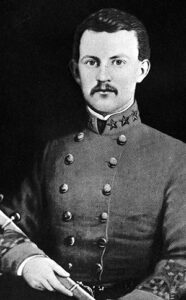Written by Leisa Greathouse; edited by Cheri Todd Molter
Although he never attended the United States Military Academy, located in West Point, NY, fifteen-year-old Henry “Harry” King Burgwyn, Jr. was sent to the area by his father to be tutored privately by Captain John Gray Foster, probably with the hope that he would get an appointment to the auspicious school. The first born of Henry K. Burgwyn, Sr. and Anna Greenough Burgwyn, Harry was born on October 3, 1841, in Jamaica Plains, Massachusetts, his mother’s ancestral home. Harry’s father, Burgwyn Sr. was of the planter class who owned a plantation called Thornbury in Garysburg, Northampton County, North Carolina. Shortly after Harry’s birth, the family moved to Thornbury, a plantation supported by at least 62 enslaved persons.[1]
Burgwyn did not get an appointment at the USMC; however, he attended the University of North Carolina at Chapel Hill instead, graduating in 1857. Afterwards, he entered the Virginia Military Institute (VMI), entering as a VMI Second Classman. Harry was one of the cadets who guarded John Brown prior to his execution on December 2, 1859. He graduated from VMI in April 1861, the same month that Confederate troops in South Carolina fired upon the federal garrison, Fort Sumter.
After finishing up his education in 1861, Harry offered his military services to North Carolina’s Governor Ellis. He was a major when the governor put him in charge of camps of instruction near Raleigh, which trained new volunteers. On the formation of the 26th North Carolina, Burgwyn was elected to Lieutenant Colonel. His commanding officer was Zebulon Vance, who would later become North Carolina’s governor. Not yet twenty years old, Burgwyn developed a plan to defend the coast: “There are two points which, in my opinion, are the key-points of this coast. One is at Captain Penders’s [sic] Battery, where both regiments [the 26th and 7th North Carolina Regiments] are now stationed, and the other is a position similar to this but about two miles nearer the fort [Macon]. … I greatly lament that I have been unable to excite more attention to the necessity of aiding nature by art and rendering our security perfect.” [2] At that time the regiment was stationed to protect Ft. Macon. [3]
In the spring of 1862, the Union Army did successfully take the majority of North Carolina’s coast. Burgwyn commanded troops at the Battle of New Bern where, ironically, he faced his former tutor, John Gray Foster, who was then a major general and commanded the Federal forces in Eastern North Carolina. In June, Burgwyn’s regiment was at the Seven Day’s Battle outside of Richmond. Later in the summer, Colonel Zebulon Vance of the 26th North Carolina Infantry bade farewell to his soldiers to take his place as the state’s new governor.[4] At the objection of General Robert Ransom, but not the soldiers’, the vacancy was filled by twenty-year-old Henry King Burgwyn, Jr. [5]
Burgwyn and his troops took part in the conflict at Rawle’s Mill, Martin County, in November 1862, at the Second Battle of New Bern in February, and at Blount’s Creek in Beaufort County in April. From there, Burgwyn and the 26th NC, which by now was in Gen. Pettigrew’s Brigade, Heth’s Division, Hill’s third corps, were transferred from the “seat of war in North Carolina” to the Army of Northern Virginia. They were destined for Gettysburg.
First day of battle, July 1, 1863, Colonel Burgwyn had over 800 troops “with a full complement of field and company officers.” [6] With claims that Burgwyn’s regiment was the largest at Gettysburg,[7] they faced the Iron Brigade. The Iron Brigade had developed the reputation for being one of the toughest units in the United States Army. [8]
Although the battle started at 10:00 a.m., at 2:30 p.m., Burgwyn with the 26th, along with the rest of Pettigrew’s Brigade, were ordered forward.[9] At McPherson’s Ridge, the boy colonel, as he was being called, took a position near the regimental colors, (the flag), and led his men with the words, “Now, boys, give them one Confederate yell, and rush in!”[10] After the tenth flag bearer fell on the battlefield, Burgwyn picked up the colors and had turned slightly to see behind him when he was shot in the side. The bullet passed through both lungs,[11] and he died a couple of hours later.[12] After the battle, the young colonel was “buried north of the Chambersburg Pike in ‘an empty gun case.’”[13] Two years after the war, in 1867, his family had his body reinterred to Oakwood Cemetery in Raleigh. Burgwyn never married and belonged to the Episcopal church.[14]
At some point during his military career, Burgwyn took with him his enslaved manservant, Kinchen. After Burgwyn’s death, quartermaster Capt. J. J. Young tasked Kinchen with returning Burgwyn’s personal possessions to his family. To read that story, click here: https://nccivilwarcenter.org/kinchen/
[1] A list of shoes and sizes from what appears to be an account page. The list was put into Ancestry.com: Slave’s shoe sizes (ancestry.com)
[2] Rockbridge County, Virginia Genealogy Trails
[3] Burgwyn, Henry (“Harry”) King, Jr. | NCpedia
[4] 26th NC Regimental History.pdf (26nc.org)
[5] Rockbridge County, Virginia Genealogy Trails
[6] Ibid
[7] Battle of Gettysburg : McPherson’s Ridge (thomaslegion.net)
[8] “No Man Can Take Those Colors and Live” | American Battlefield Trust (battlefields.org)
[9] Ibid
[10] Rockbridge County, Virginia Genealogy Trails
[11] North Carolina State Troops: Gettysburg After Action Reports #3. A letter from the 26th’s quartermaster, Capt. J. J. Young.
[12] “No Man Can Take Those Colors and Live” | American Battlefield Trust (battlefields.org)
[13] Licensed Battlefield Guide Rich Goedkoop: The Iron Brigade Part 7 | Gettysburg Daily

